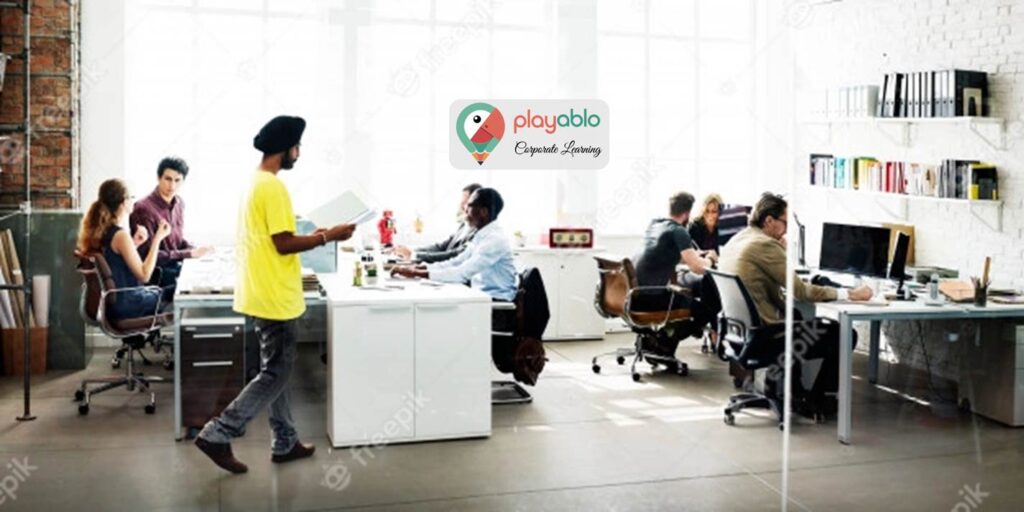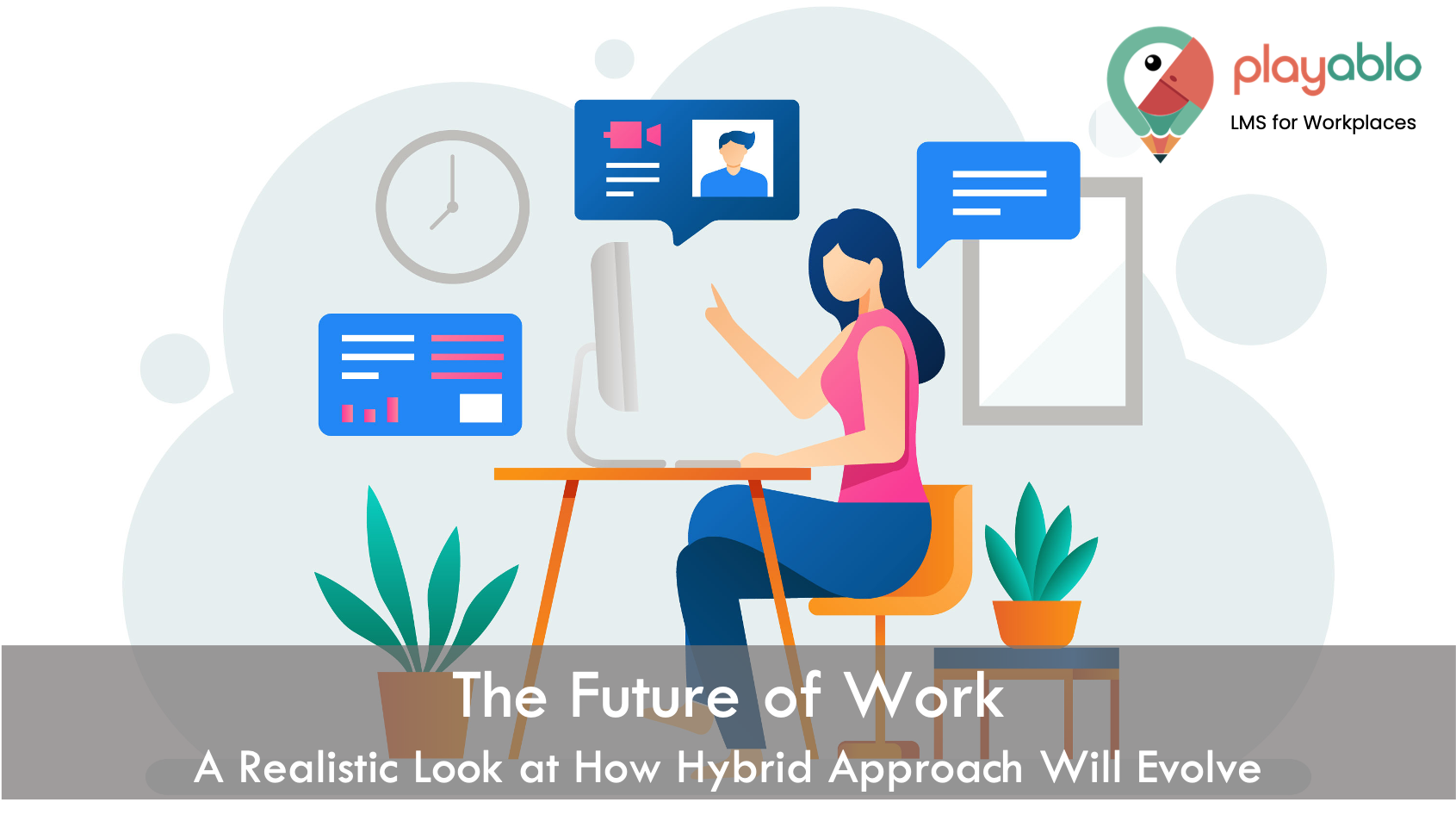What’s the future of work in the next few years? Well, it’s the hybrid model! 72% of employees say that moving forward, they prefer a hybrid approach and a mix of remote and office work. So, where did it all start? Well, the idea of adopting a flexible work environment had been under consideration for over a decade now.
But with the onslaught of COVID-19, employers have been forced to rewrite the rules — quickly. Now, organisations are rapidly introducing remote working, which has set the bar for the new status quo. Physical places will never become obsolete. But the structure has to be redefined to fit the new future of work. And this is where a hybrid model comes in.
Table of Contents
What is a Hybrid Model and How is it Beneficial for the Future of Work?

With the transformation of the physical workplace, we should be prepared to change our traditional expectations around the way and the hours we work. Employee experiences must evolve as organisations transit toward a more hybrid model. Neither can everyone work at the same time — whether it’s online or offline. They will instead work at a schedule optimised as per their circumstances.
A survey carried out by Deloitte explains how a digitalised workplace will become a norm in the future: “34 per cent of the surveyed respondents anticipate having more flexibility and autonomy to decide when and how to perform their work. Thirty-two per cent expect increased digitalisation of the workplace and attention to cybersecurity, and 27 per cent expect more trust among colleagues and across hierarchies.”
Yes, the future of work will demand the perfect amalgamation of technology and humans. And this shift will positively impact companies in mainly three ways:
Employees Scattered in Different Locations Globally

With telework becoming a norm, several businesses will witness the upsides of flexible work policies. They will have the option to either be partially or fully remote. What does this entail? They can recruit employees across time zones, expanding their talent pool. Businesses who have implemented telework practises have discovered that they may save money on overhead, provide greater work-life balance to their employees, and hire from a growing pool of talent. They can also put the rent and cost savings towards staff retention.
Read More: Digital Transformation and its Impact on Workplace Learning
The future of work will also require companies to change their approach even if they have a physical office. The typical desk-based workspace with a daily commute, elevators, and community kitchens will no longer exist in offices. The new office space will evolve into hangouts for collaboration and connection to foster face-to-face bonding, camaraderie, and group thinking.
The demand for social separation will lead to new layouts, where start-up culture formerly inspired open floor plans, huge common spaces, and meeting rooms. Employee shifts may be staggered for companies that demand in-office work to accommodate fewer workers in the office at the same time. Some may even opt to go back to cubicles and plexiglass barriers, combining safety precautions with possibilities for constructive engagement.
Increase in Value-added Programs
Many firms have expanded their mental health and wellbeing offerings in innovative new ways due to the considerable stress placed on employees during the pandemic. Some organisations, for example, provide monthly virtual team meditations led by prominent psychology experts.
Employees appreciate the flexibility of these programmes, which contain a clear commitment to the organization’s overall well-being. Leaders recognise that providing genuine support to their teams allows them to perform at their best, with additional resources accessible as required.
Read More: Workplace Learning in 2021 | It is the Worst of Times, It is the Best of Times!
Wellness is currently a principal focus that addresses the emotional health commitment that firms are encouraged to provide to their employees. Employees’ mental and physical well-being is aided by focusing on employee-valued initiatives. Before the epidemic, it was more important to get to work than stay at home when sick.
As many firms help their employees overcome the stress and isolation that comes with quarantining, an overall focus on wellness in the future of work will address holistic health. Employers who are more concerned about their employees’ health during this time will set long-term patterns that will hopefully persist after the pandemic is over.
Minimisation of Environmental Impact

The present work culture has wholly ditched the routine of five-day commutes in high-emission vehicles to and from the office. Many business visits are now following the virtual formats due to the widespread use and growth of virtual events and conferences. As a result, this change has led to a significant drop in business travel. Reduced high-emission travel is already a significant contribution to reducing climate change, and increasing the use of remote work practices will bolster this trend.
Read More: How eLearning Can Help in Reducing Carbon Footprint in Your Organisation!
With the future of large-scale gatherings still undetermined, an increasing number of businesses are opting for virtual events. Virtual networking will become the norm as both hosts and participants become more familiar with it, resulting in overall efficiencies. A professional who might have previously paid thousands of dollars to fly to an event can now do so virtually for less money and with less environmental impact. On the other hand, internal gatherings and celebrations are inspiring new inventive ways to interact digitally with one another.
What Are the Challenges in Introducing a Hybrid Working Model?
Yes, the hybrid model will be the new norm in the future of work. But it does come with its downsides since it promotes a two-tier approach. We do not have a one-size-fits-all method to going hybrid. However, several steps can determine the success of any hybrid strategy.
The 60-30-10 Rule
Ruth Wageman and Richard Hackman developed the 60-30-10 rule. The rule focuses on the differences in team performance. The team design is responsible for 60% of the variable in team performance. The quality of team launches is responsible for 30% of the variance in team performance. In contrast, the leader’s ability to coach the team attributes only 10%.
So, how do we incorporate this rule in your hybrid team design?
Team Design (60%): The majority of leaders are taught that their primary responsibility is to coach their teams. On the other hand, coaches are responsible for only around a tenth of a team’s performance. Much more crucial is team design, which lays the groundwork for efficient teamwork. Despite this, team design is frequently disregarded.
In a hybrid environment, selecting what amount of “hybrid-ness” your team should embrace and how that will seem is an essential component of team design. This approach shouldn’t be haphazard; the days and hours that your hybrid strategy leverages should be deliberate.
Read More: 8 Strategies to Build Super Successful Workplace Learning Teams
Ad: PlayAblo’s Enterprise-Grade Micro-Learning platform is built for millennial learners. Micro-Learning, along with assessments and gamification features, ensures learning outcome measurement along with sustained engagement.
Find out more and request a custom demo!
Great teams are built on an intentional design. As a leader, you must carefully consider how you will structure your hybrid teams. You should probably go back to the drawing board if your strategy is the same as it was when everyone worked in an office every day.
Launches (30%): Launches and “relaunches” are crucial in the context of remote and hybrid labour. Relaunches let teams press the reset button, whereas launches are vital for detailing their steps to execute their tasks. Any time a substantial change occurs, a relaunch should take place. The following types of events warrant a relaunch in the context of hybrid teams:
- Trying out a new level of hybrid-ness or adopting a new hybrid work arrangement, such as reuniting your teams in an office.
- Using a new collaboration or project management tool
- Establishing a new office
Read More: The Comprehensive Guide To Selecting the right LMS for Contact Centre and BPOs
Coaching (10%): In a blended work context, coaching must change. Managers must move their focus away from attendance and onto performance and outcomes. Managers must also coach to foster psychological safety, so that team members feel comfortable working in an atmosphere where face-to-face contact is no longer the norm.
Leaders, in particular, should strive to be as hybrid as their team members. Harmful disparities will grow swiftly unless leaders lead by example.
Conclusion: Incorporating a New Paradigm to the Future of Work
Many of the executives state that they are confused when they implement new hybrid work arrangements. But, in reality, this new era of hybrid work is the result of years of research. Although the tactics may be different than in the past, the markers of good teamwork will stay essentially unchanged. According to decades of research, the effective hybrid teams of the future of work will be defined by team design, launches, and coaching—in that order.
Ad: PlayAblo’s Enterprise-Grade Micro-Learning platform is built for millennial learners. Micro-Learning, along with assessments and gamification features, ensures learning outcome measurement along with sustained engagement.
Find out more and request a custom demo!







Comments are closed, but trackbacks and pingbacks are open.